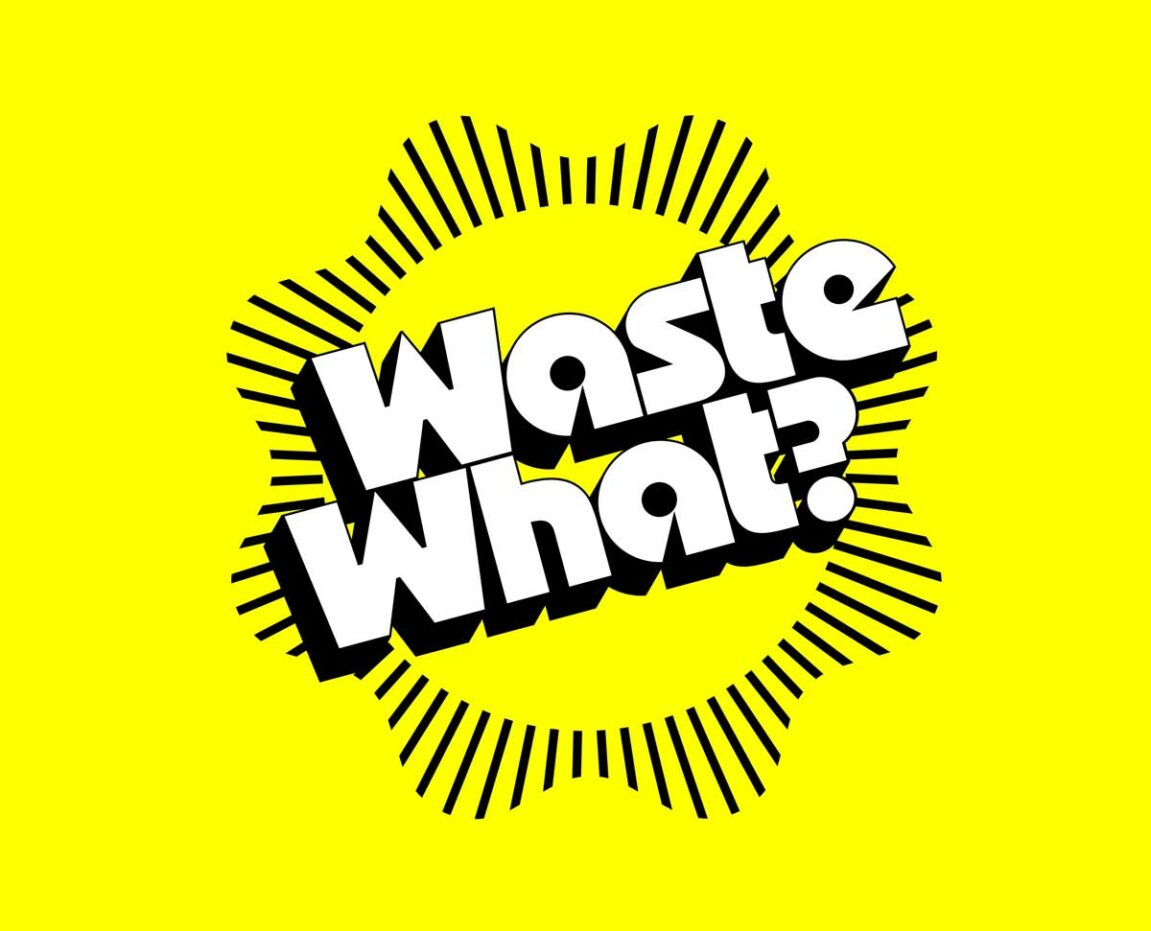
These are the long instructions needed to play Waste What?
Ausführliche Spielregeln auf Deutsch
Scenario
A constant avalanche of materials flows through our cities every day: packaging, food that is never eaten, electronics that are quickly outdated, cheap textiles to feed the fast fashion frenzy, furniture and construction materials for temporary spaces. From production to recycling or disposal, these industrial-scale material flows produce emissions and other negative environmental impacts, and take a lot of labor to handle!
In many places around the world, citizen projects are working to do something about it, trying out many ways to keep stuff in use. These initiatives many times struggle to decide what is waste and what is not.
Your city is such a place, what will you do about it? Form a material recovery initiative and fight against things being turned into waste!
Waste what? explores how we can think about materials differently, trying out many ways to keep stuff in use.
Your Role in the Game
In Waste What? you play as a material recovery initiative. In many cities, associations, small companies and local initiatives are working together to give new life to discarded materials.
Your goal as one of those material recovery initiatives is to creatively find new uses for discarded things, closing loops and reducing the amount of waste that is burned.
You are specialized in different areas, such as: Textile, Furniture, Bikes, Food, Construction Materials and Electronics. As you repair, recombine and re-purpose materials, your knowledge and skills grow.
To maximize your impact you can also work together with other initiatives!
Winning and Losing
This is a cooperative game for 2 players or teams at a table. Even if each initiative has its own specializations, dynamic and needs, this means that you either win together or lose together.
You win if you make it through all 6 rounds and keep CO2 levels in check whilst you are still able to pay for rent.
You lose if any player cannot pay their rent at the end of a round or if you emit all 3 CO2 tokens in the waste burning facility
Tip: See the Difficulty Levels at the end of this document for a quick start and adjusting the difficulty for you experience.
What’s in the box?
The game comes with
– 1 game board
– 1 short instructions
– 2 Reminder cards
– 7 Skill cards
– 54 Waste cards
– 18 Just Waste cards
– 6 blank Combo cards
– 20 Event cards
– 2 Storage cards
– 1 Recycle Bin card
– 10 green tokens (money)
– 10 blue tokens (Rounds, CO2, and level markers)
– 1 dice
In addition, you will need a non-permanent pen to fill out blank cards.
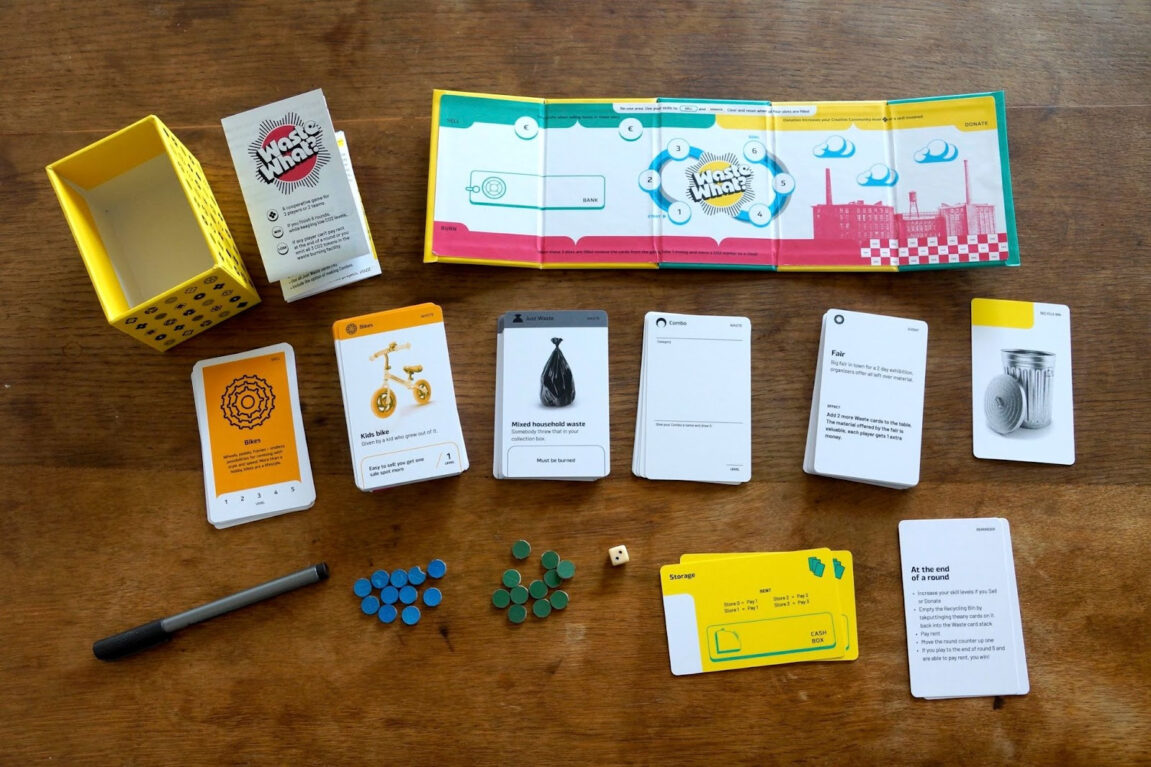
1. Setting up each player’s space
Start by setting up the space for each player.
– Each player gets a Storage Card and places it in front of them.
– Each player puts 2 green Money Tokens in the Cash Box on their Storage card.
– Shuffle all Skill cards and remove one from the game without looking at it.
– Take turns choosing from the remaining 6 Skill cards. If this is your first game, just choose randomly.
– Place a Blue Token at Level 1 on each chosen Skill card.
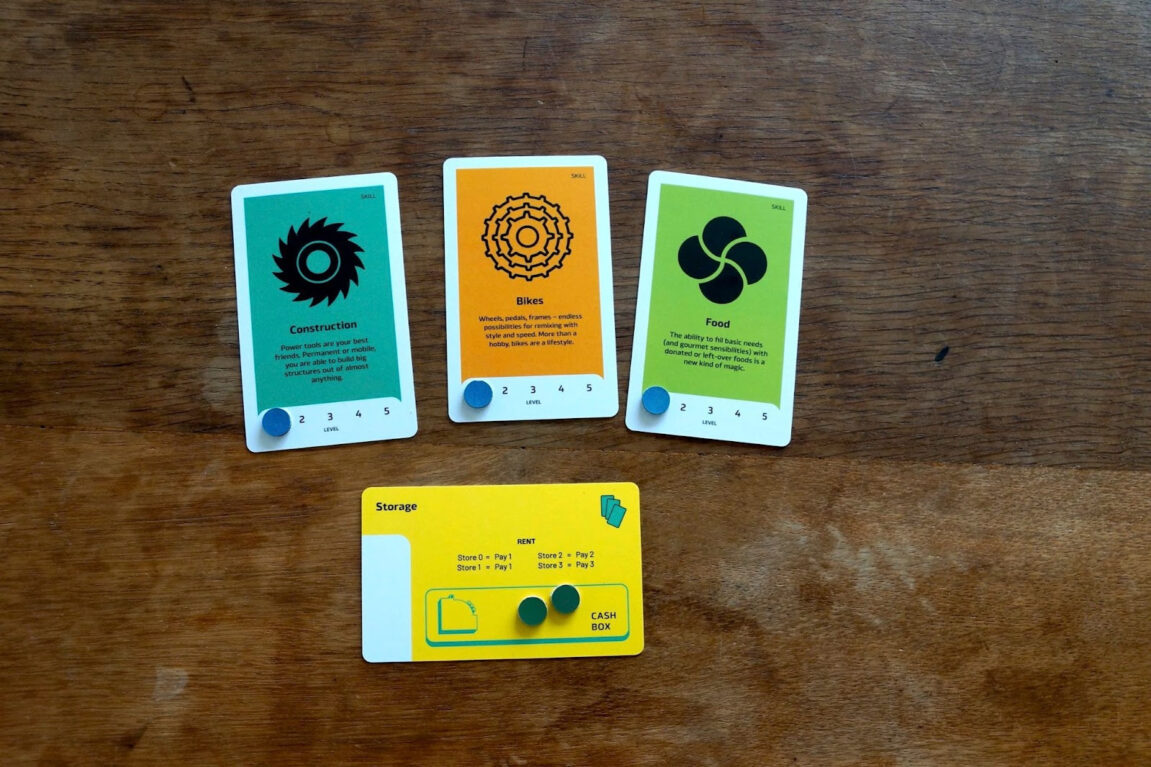
2. Setting up the shared playing area
Once you’ve set up both players like this, continue to set up the shared playing area.
– Place the board (box interior) flat on the table.
– Place 2 green money tokens on the selling slots and the rest in the bank.
– Place 3 blue CO2 tokens on the incinerator (the building on the board).
– Place the blue Round Counter at round 1.
– Place the Recycle Bin card next to the board.
– Shuffle and place the deck of Waste and Event cards facing down in 2 separate stacks.
– Have the blank Combo cards, dice and a pen close by.
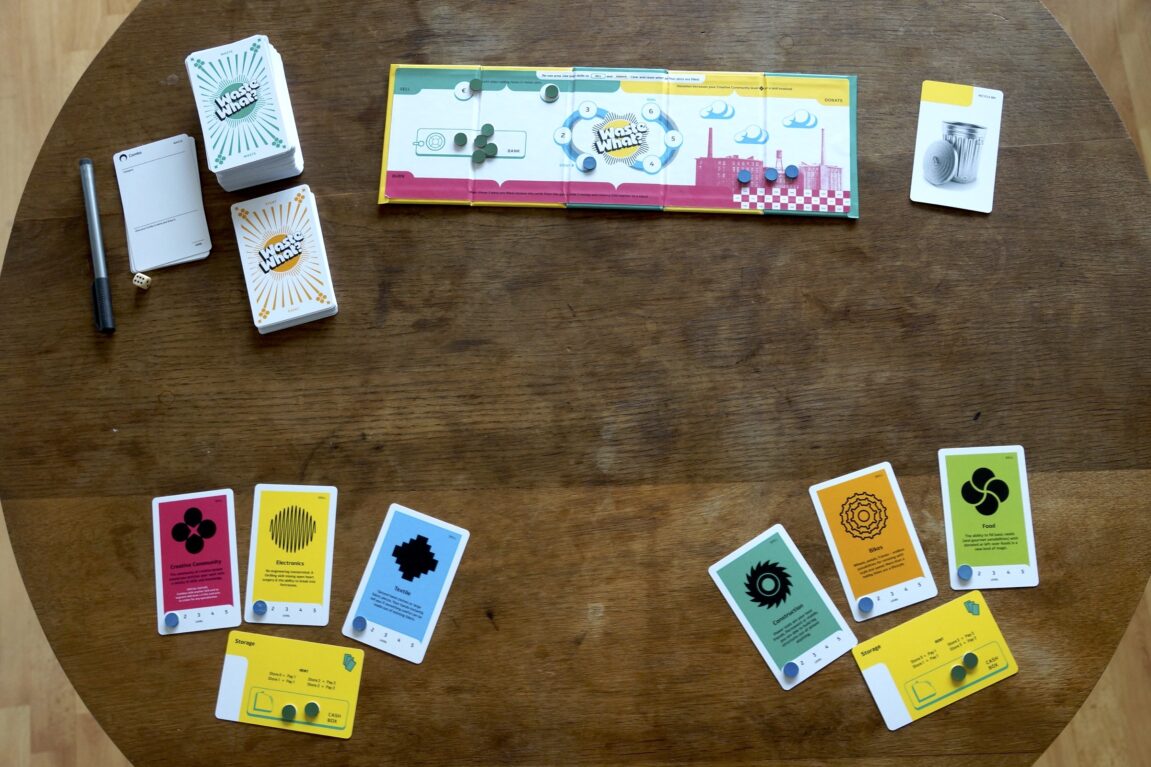
3. Beginning a new round
Waste what? is played in rounds that both players go through together. At the beginning of each round, there are a few setup tasks that must be completed before you can start.
– Shuffle the deck of waste cards (yes, it is shuffled each round!)
– Starting in round 2, draw 1 Event card and observe its effects.
– Draw 6 Waste cards and place them face up at the center. This is part of the waste that continuously piles up in your city and that you as material recovery initiatives want to repurpose.
– Now both player/teams discuss what to do with the waste cards. You must do something with each waste card to continue. You can Reuse (Donate / Sell), Recycle, Store or Burn. (see section 5).
4. Ending the round
After you’ve delt with all the Waste Cards on the table, there are a few steps before moving on to the next round and getting new Waste Cards.
– Hopefully you gained expertise by reusing Waste Cards. Don’t forget to increase your skill levels when selling or donating.
– Empty the Recycling Bin by taking any cards in it back into the waste card stack.
– Pay your rent.
– Move the round counter up one.
– If you play to the end of round 6 and are able to pay rent, you win.
5. What you can do with the Waste Cards
Just like regular waste, you can Reuse (Sell or Donate), Store, Recycle or Burn Waste cards. To Reuse waste, you must use your skills. To Store, Recycle or Burn waste you do not need any specific skills. Once you have decided what to do with the Waste card, place it on the corresponding Reuse, Store, Recycle or Burn slots. Each round you must decide to do something with all Waste cards on the table to continue.
Reusing Waste (Selling or Donating)
Before you can Sell or Donate Waste, you must use your Skills. Imagine that you need to repair, upgrade, recombine, clean, or sort items, before you can reuse them. This requires special skills.
There are a few simple rules when it comes to using your Skills to Reuse Waste.
– You can use each Skill card on just one Waste card (or combo) per round.
– You have to have the right Skill to Reuse the Waste. (e.g. to reuse furniture, you need the furniture skill.)
– Your Skill Level (indicated by the marker on your card) must be high enough to handle the waste complexity (number on the waste card).
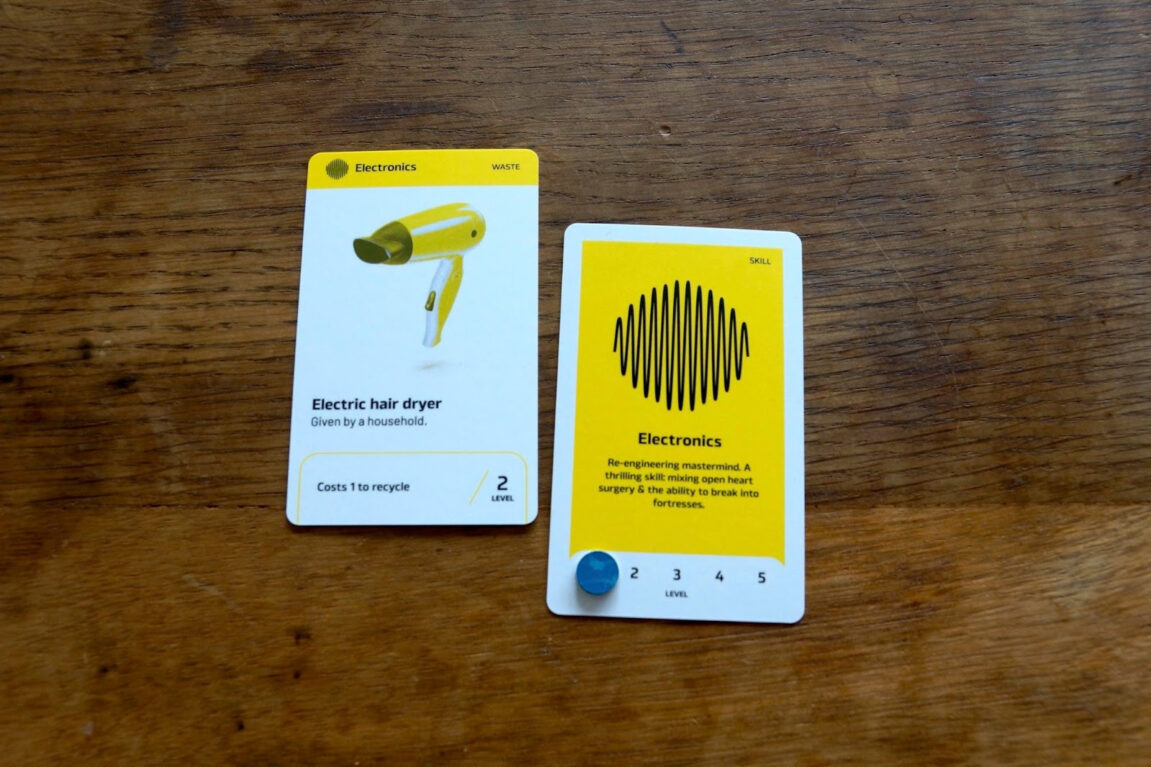
Tip: Work together to combine skills from both players! Move the Skill cards into the work area to plan out what you can do with the waste. This helps you keep track of which skills are used in the round.
The Creative Community card is a powerful, special Skill card:
– Use it to compensate for a missing skill level, by adding it to a skill card to reach a higher level. (e.g. your electronics skill is only at level 1, but you want to process a broken toaster with complexity 2. Add your creative community to reach 2).
– If your creative community card has reached level 4, it can take on the role of any skill card (e.g. you can use it to process furniture, even if you don’t have that skill)
– Like the other skill cards, you may only use the creative community card once per round
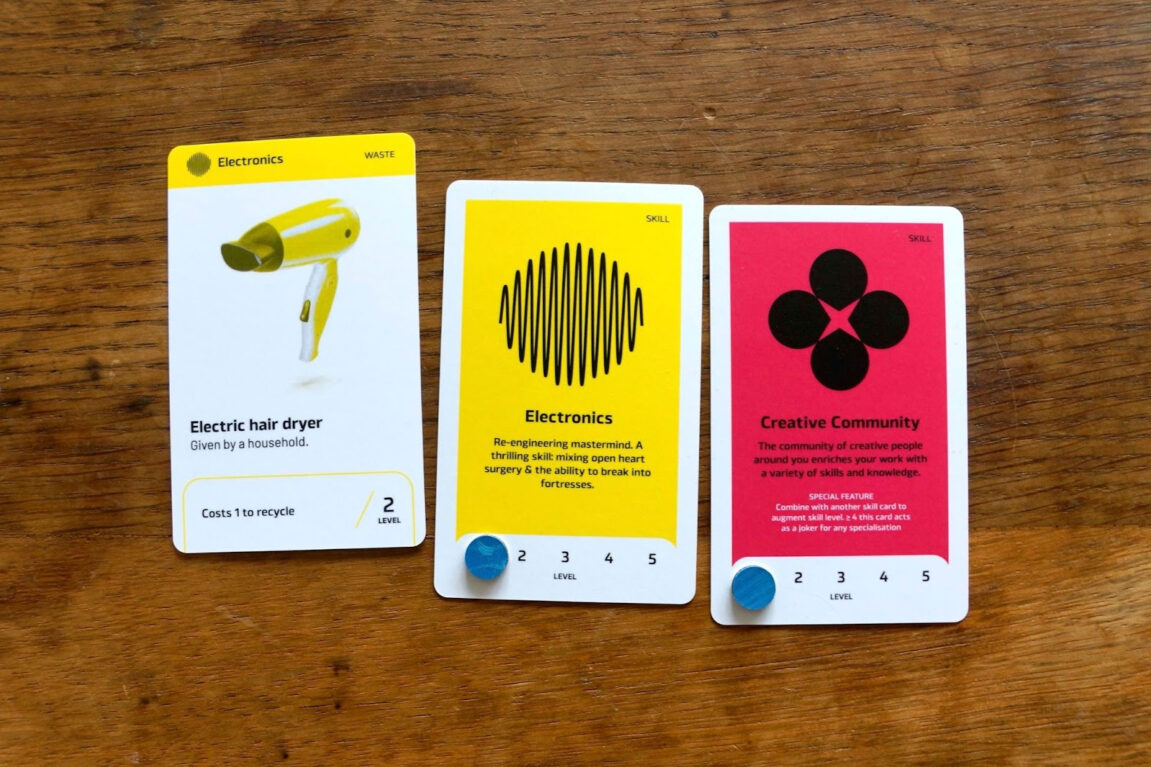
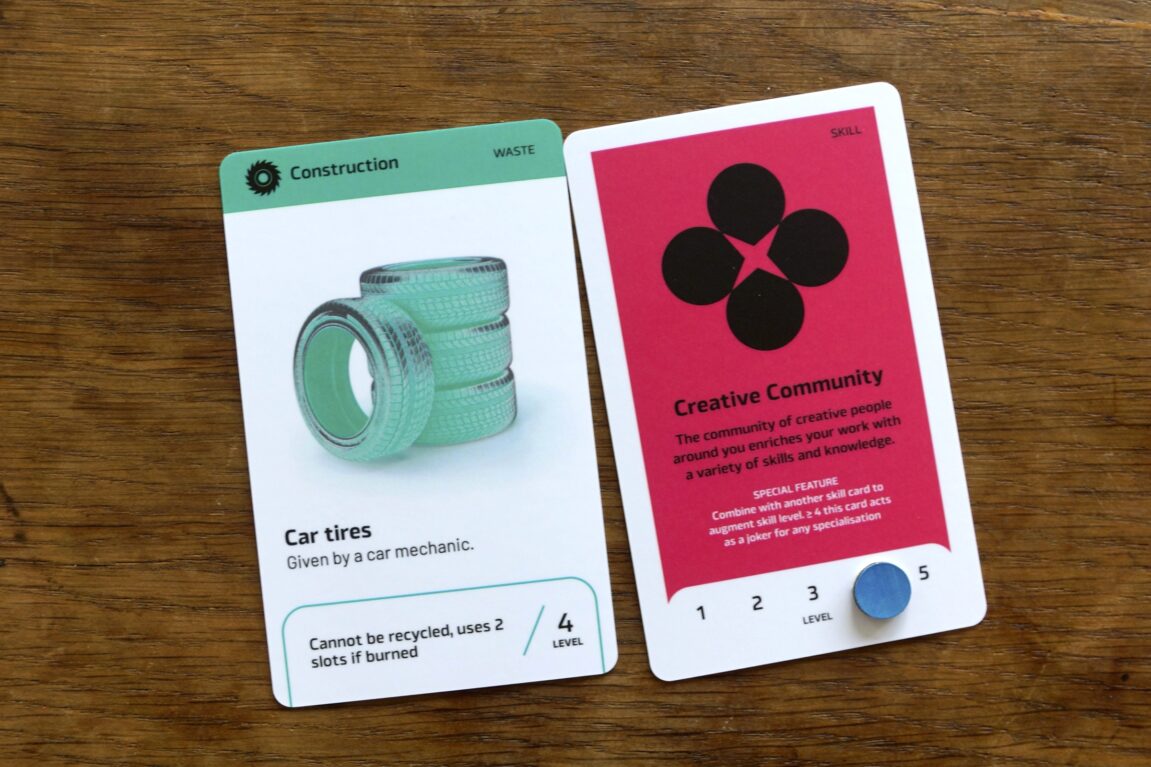
If you have the skills needed to Reuse Waste cards, they can be placed on the Sell and Donate slots on the board. You can Sell or Donate depending on what slots are left.
When you Sell, collect 1 money from that slot and increase the skill level of one card used to reuse that waste (excluding the creative community card), right after putting the card on the slot.
When you Donate, increase the skill level of one card used to reuse that waste or increase 1 level on a creative community card of your choice, right after putting the card on the slot.
The Sell and Donate slots are cleared and reset at any moment during a round when all four slots are filled. Sold and donated items go back into the waste card stack.
Important: You cannot sell or donate items that you did not use a Skill on!
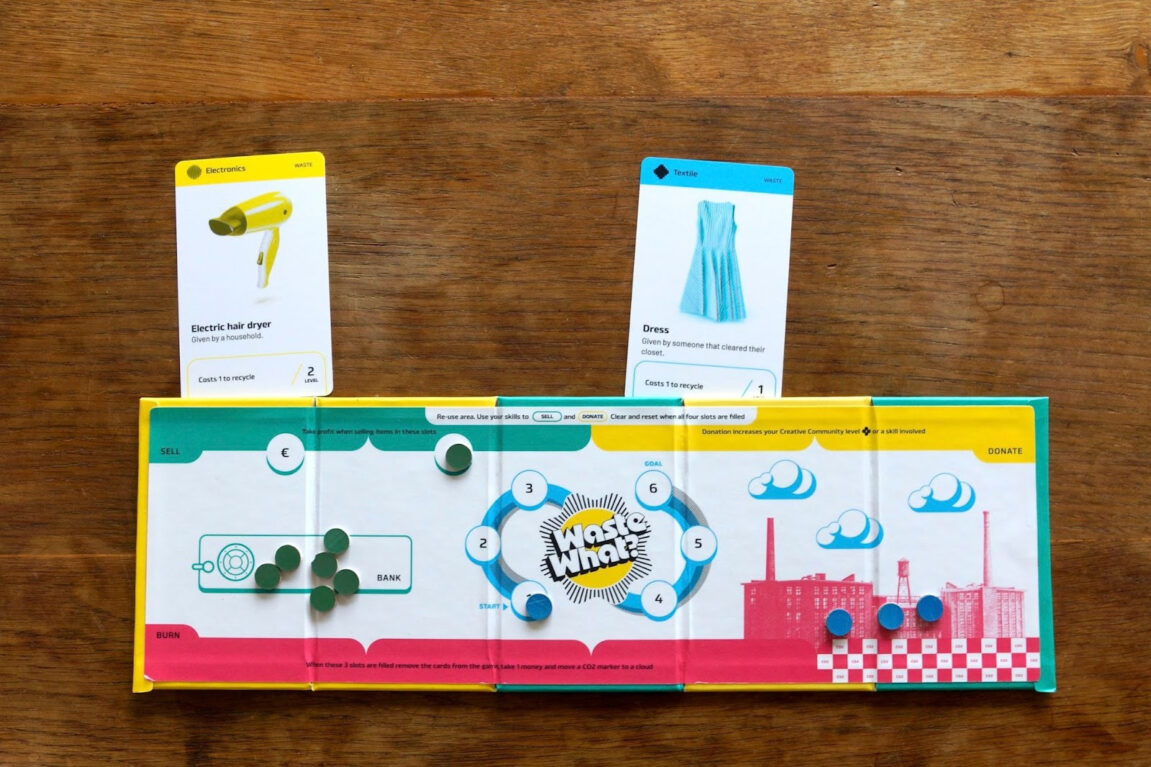
Storing Waste cards
If you don’t have the skills to reuse a Waste card and don’t want to recycle or burn it, you can keep Waste cards in the Storage area and reuse them later. (You can even store Just Waste cards).
But the more you store the more rent you will need to pay.
– Rent costs 1 whether you have no cards or up to 1 per round.
– Then the cost rises with each further card you store.
For example, if you have no cards or just 1, you pay 1. If you want to store 2 cards, you must pay 2 rent; you will need to pay 3 rent for 3 cards, and so on.
You must pay rent at the end of each round.
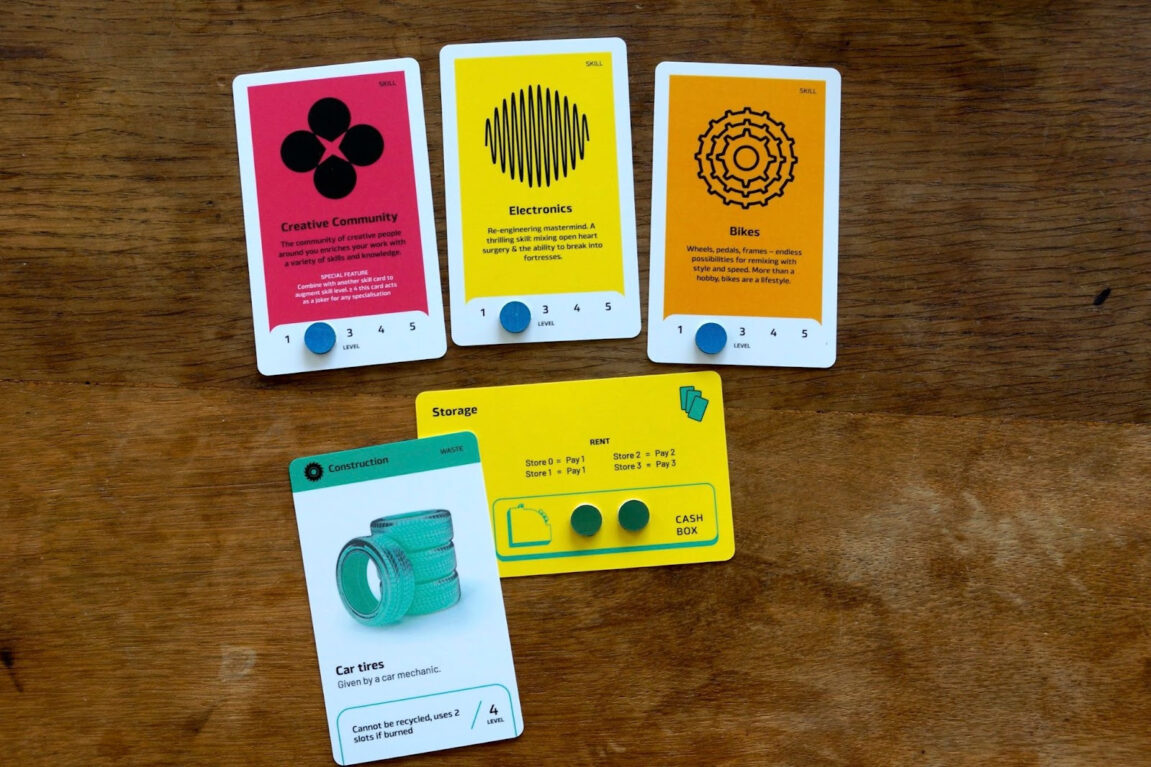
Recycling
To recycle a Waste card, just place it on the Recycle Bin. The recycle bin is emptied at the end of each round, taking any card on it back into the waste pile. But there are a few limitations on recycling
– You can only recycle one card per round.
– Beware of the special rules and effects on the Waste card – some items might not be recyclable, or cost extra money. This is because currently, when recycling some materials, such as textile and electronics, you lose most of the materials’ value (that is why this process is technically called ‘downcycling’).
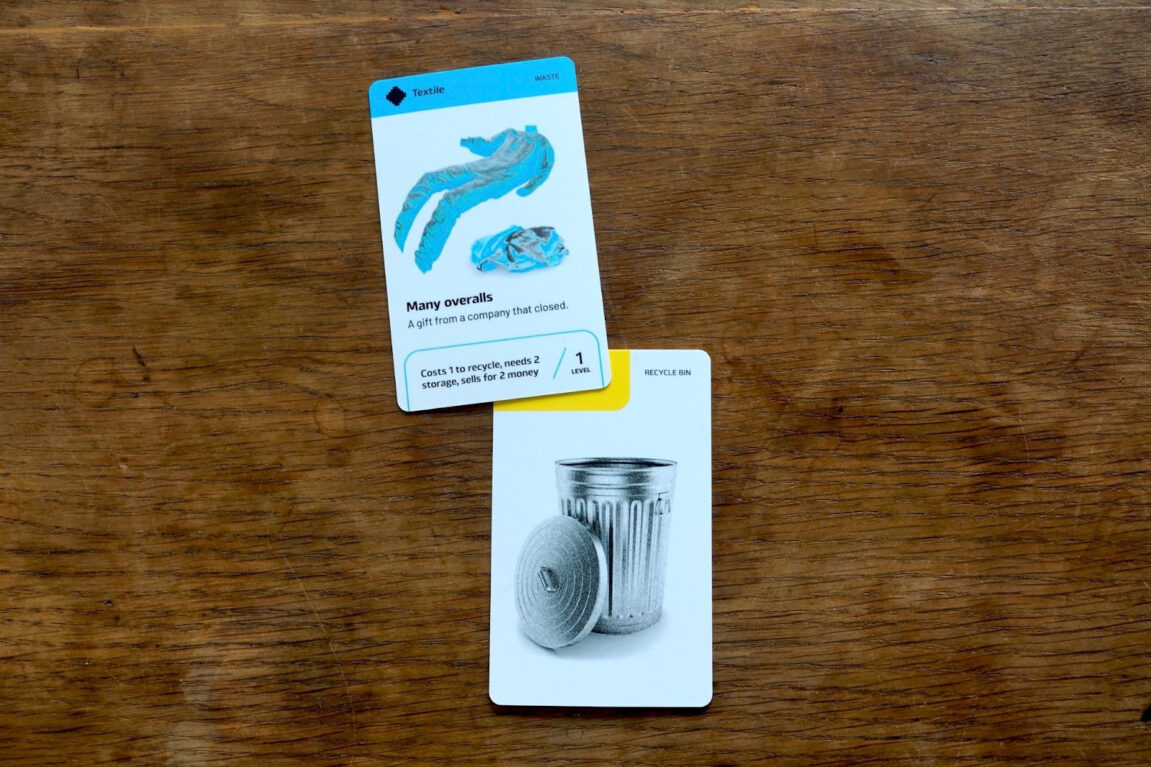
Burning waste cards
Items that cannot be Reused, Stored or Recycled must be burned. When you Burn cards it produces CO2, but you also get money from the energy that is released during the incineration.
– One CO2 marker is released when the third burn slot is filled. Move the CO2 token from the incinerator to the cloud and remove the three burned waste cards from the game.
– Take 1 money token at the same time CO2 is released. You decide who gets the money.
– When the third CO2 token is released, you immediately lose the game.
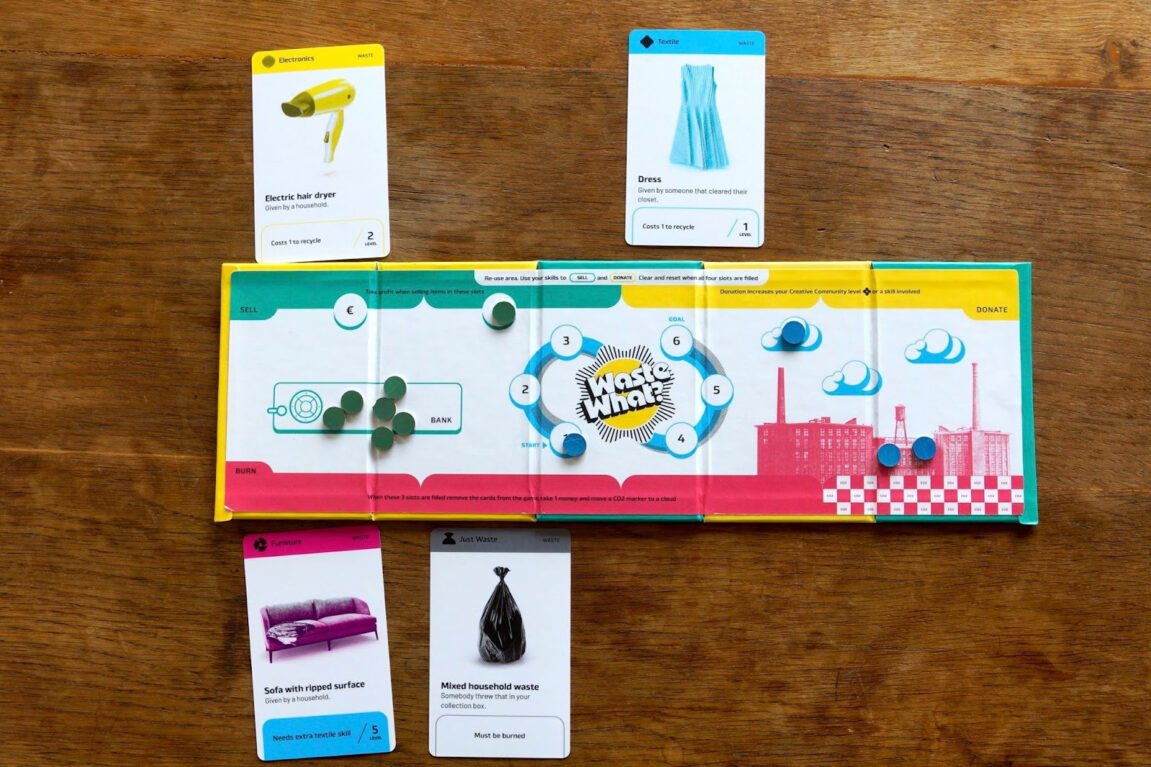
6. Combos
To successfully manage the avalanche of material, you’ll need to get creative and combine multiple Waste and Skill cards. This helps reduce the number of Waste cards you need to deal with.
All Combos must follow these rules:
– There has to be a Skill card for each Waste category in the combo.
– Every Skill card you use must be represented in the Waste combo.
– All Skill levels added together should be equal or higher than all Waste levels added together.
– The Creative Community rules apply as described above.
Once you’ve decided on a combo, fill out a new blank Combo card using a non-permanent pen (not included) and place it on top of the cards in your combo.
– Give your new item a name and draw it.
– Set the complexity level to the highest of the cards in the combo, and decide in what category it fits best (e.g. Food, Bikes, etc).
– You cannot Recycle Combo cards.
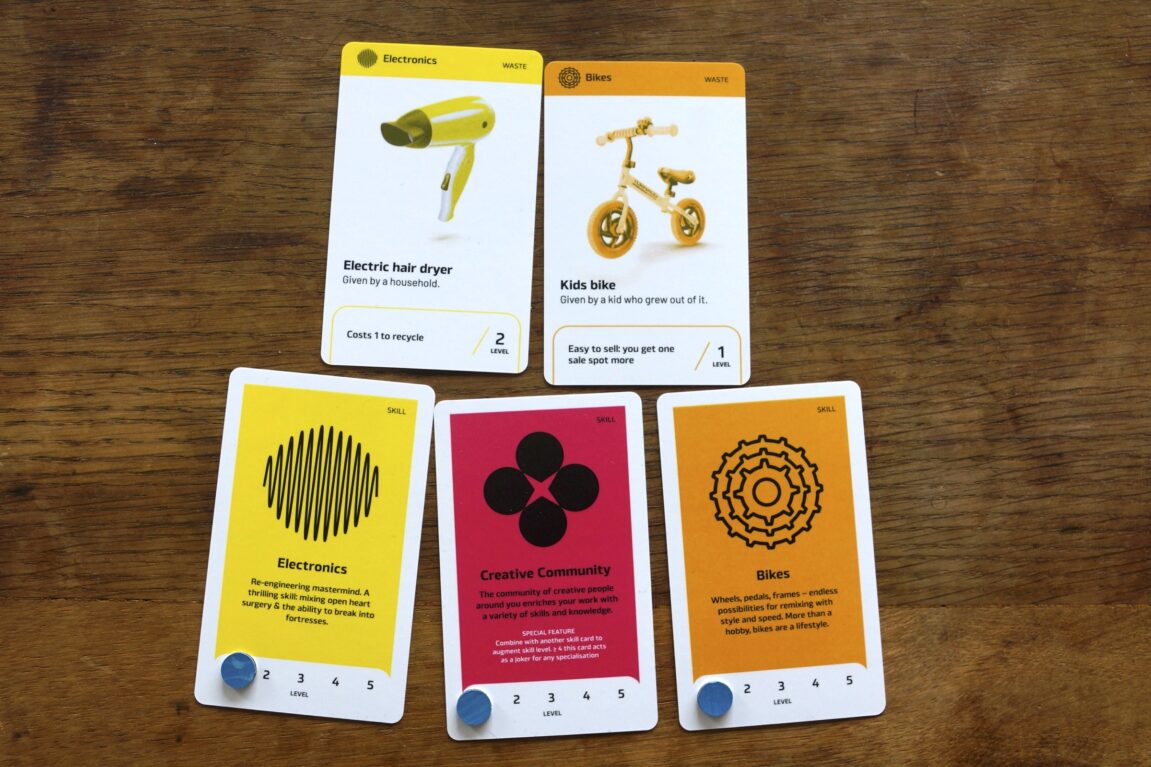
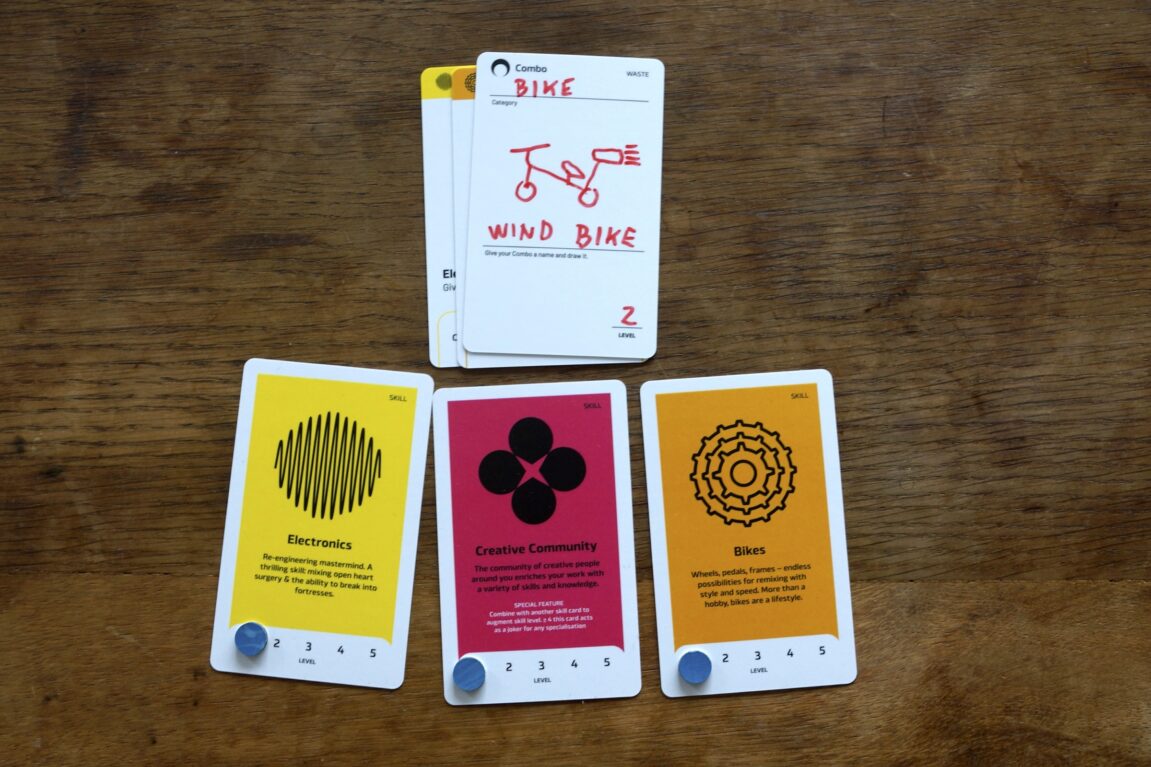
Warning: you might not be able to Sell or Donate COMPLEX COMBOS! If you’ve created a Frankenstein, you might not be able to sell or donate it. Roll the dice to determine if your Combo will be accepted. You must roll a higher number than the number of cards in the combo.
If not accepted: you must take it apart and deal with the componing waste cards individually (Sell,
Donate, Store, Recycle or Burn).
If accepted: Use the new combo card in the game and take the cards that went into it out of the
game. Your accepted combo card will be treated as a new waste card and re-shuffled back into the deck when you Sell or Donate it.
7. Difficulty levels
Waste What? Can be played with different difficulty levels:
– Beginners round:
- Use only 9 Just Waste cards (Waste cards with gray heading)
- Don’t include the option of making Combos
– Normal round:
- Use 12 Just Waste cards
- Include the option of making Combos
– Difficult round:
- Use all Just Waste cards (18)
- Include the option of making Combos
Credits
Waste What? is the main result of the project “Trash Games: Playing with the Circular Economy at Haus der Materialisierung” (2021-2022), funded by the Berlin University Alliance
CC NY NC SA Trash Games, 2022
